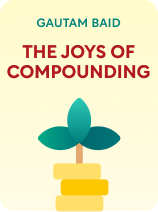

This article is an excerpt from the Shortform book guide to "The Joys Of Compounding" by Gautam Baid. Shortform has the world's best summaries and analyses of books you should be reading.
Like this article? Sign up for a free trial here.
How can you use investing advice to improve your everyday life? What can you do to improve your decision-making skills?
In The Joys of Compounding, Gautam Baid covers how to make meaningful investments in six life areas. He also includes how to maximize financial returns to gain wealth and financial independence.
Read below for a brief overview of The Joys of Compounding.
The Joys of Compounding by Gautam Baid
You may have heard of the compound effect—where an investment grows not only in the principal amount but also in the interest earned, leading to exponential growth over time.
Investment portfolio manager and best-selling author Gautam Baid argues that compounding isn’t just a financial concept. Rather, it’s a transformative principle that can grow both your bank account and your sense of personal fulfillment. In The Joys of Compounding, he draws on the wisdom of legendary investors, including Warren Buffett and Charlie Munger, to provide actionable strategies for boosting both your finances and your overall life satisfaction.
This article covers Baid’s strategies in two parts:
- Part 1 offers strategies for compounding your well-being and happiness, ensuring that you’re healthy and happy enough to enjoy your financial success.
- Part 2 presents practical strategies for compounding your investment portfolio, enabling you to achieve steady and sustainable financial growth.
Part 1: Strategies That Compound Your Well-Being and Happiness
If you’re reading this guide for advice on financial investments, you might wonder why we’re first focusing on your well-being and happiness. According to Baid, true wealth isn’t just about amassing money. Rather, it’s about achieving overall well-being and experiencing genuine fulfillment and happiness. After all, there’s no point in having lots of money if you’re too sick or unhappy to enjoy it.
Baid argues that just as compounding in finance allows small investments to grow exponentially over time, practicing life-enhancing strategies can have a similar compounding effect on your happiness and well-being. He offers two insights for maximizing the benefits of such strategies.
First, start them early to maximize their cumulative benefits—think of how contributing to your pension in your twenties allows it to grow more due to longer compounding than if you start in your forties. Second, practice them consistently to ensure a steady, continuous impact on your well-being—consider how you’re more likely to meet your health goals by exercising every day than by working out intensely for just a month and then stopping.
Bearing these insights in mind, let’s cover Baid’s six strategies for compounding well-being and happiness:
- Nurture your mental and physical health.
- Pursue your passion.
- Live authentically.
- Build positive relationships.
- Engage in continual learning.
- Achieve financial independence.
Strategy #1 Nurture Your Mental and Physical Health
According to Baid, nurturing your mental and physical health is akin to tending a garden—as you consistently care for and feed each plant, the garden flourishes. Similarly, consistently applying the following five practices will allow you to fully engage in and appreciate every moment of life:
Establish healthy habits: Adopt routines that support your physical and mental well-being, such as consuming nutritious foods, exercising regularly, staying hydrated, getting enough sleep, and effectively managing stress.
Think long term: Make daily choices with a focus on their long-term impact on your health and quality of life. Avoid sabotaging behaviors that may harm your future well-being to ensure that you can enjoy life for many years to come. For example, regularly drinking water with your meals will positively impact your long-term health, while drinking sugary soda may lead to chronic health issues.
Engage in mentally stimulating activities: Participate in activities that challenge your mind, such as solving puzzles or learning new skills. These activities reduce stress by diverting your focus from daily worries and keeping your mind sharp and adaptable.
Be conscious of the information you consume. Avoid sensational and negative news to maintain a clear and positive mindset. Consuming positive and informative content can help you stay emotionally balanced and focused on what truly matters.
Practice gratitude: Cultivate an appreciative attitude by acknowledging the positive aspects of your life. This mindset shifts your focus from what’s lacking to what makes you happy, fostering resilience in challenging times.
Strategy #2: Pursue Your Passion
Just as a compass points north, Baid believes your passions serve as a guide to a deeper, more fulfilling life. Consistently channeling your energy into these passions compounds the richness and joy of your life experiences. He breaks down the journey of discovering and acting on your passions into a three-step process:
1) Reflect on your interests: Identify activities or subjects that genuinely excite you and resonate with your values. These interests provide a roadmap to what truly matters to you.
2) Set specific goals: Choose one primary goal or project related to your identified interests and take immediate action to make progress. Setting clear objectives ensures that you’re actively working toward a more fulfilling life.
3) Dedicate focused time: Allocate uninterrupted daily time to focus on your chosen goal or project. Minimizing distractions will maximize your productivity and enable you to make meaningful progress toward realizing your passion.
Strategy #3: Live Authentically
Living authentically means being true to your genuine self and values, much like an oak tree that remains rooted and unyielding amidst life’s changing seasons. By honoring your inner essence, you spark self-discovery and personal growth, thereby compounding the richness of your life experiences. Baid’s advice for embracing unwavering authenticity includes:
Be true to yourself: Act in alignment with your beliefs and values, rather than shaping your choices and behaviors to gain approval from others. This ensures your choices reflect your true self, fostering self-respect and self-confidence. For example, your friends dine at trendy restaurants but you choose your local diner because you genuinely enjoy simpler meals.
Remain open-minded: Embrace change—by learning from your mistakes, adapting to fresh perspectives, and questioning ingrained habits or beliefs. This proactive approach deepens your self-awareness, ensuring you stay aligned with your evolving, authentic self.
Maintain a journal: Document your thoughts, decisions, and experiences to clarify your ideas, identify your strengths and weaknesses, and learn from your experiences.
Strategy #4: Build Positive Relationships
In the same way a tapestry grows richer and more intricate with each thread, every positive interaction and shared experience strengthens and enriches the fabric of your life over time. Baid’s guidance on intentionally weaving these threads to build positive relationships includes:
Focus on shared goals and values: Cultivate strong bonds with like-minded individuals to create mutual support and enhance your sense of belonging.
Embody trust and respect: Act in ways that earn trust, respect, and admiration, treating others as you would like to be treated. This fosters mutual respect and strengthens your relationships.
Express appreciation: Show gratitude to those who positively impact your life to reinforce the bonds of your relationships and foster a sense of interconnectedness.
Strategy #5: Engage in Continual Learning
Just like an artisan hones their skills over time to master their craft, continual learning sharpens your mind, fueling personal and professional growth and helping you adapt to life’s evolving challenges. Baid’s suggestions for embedding learning in your everyday life include:
Schedule learning time: Find time for acquiring new knowledge or honing your skills by eliminating unproductive tasks that don’t contribute to your growth or well-being.
Explore diverse disciplines: Study a variety of fields to draw insights from different knowledge domains. This will expand your perspective and enrich your problem-solving skills.
Read regularly and extensively: Explore a wide array of subjects to expose yourself to diverse perspectives. Employ active reading techniques, such as annotation, to deepen your comprehension and enhance memory retention.
Learn from successful people: Identify people who inspire you and study their experiences to gain valuable insights and accelerate your personal development. You can do this by reading biographies of great thinkers or connecting with individuals you know and admire.
Practice fundamental reasoning: Deconstruct complex concepts to their essence to understand how they apply and why they matter. For example, understand chemical reactions by grasping the fundamental principles of why and how molecules interact.
Strategy #6: Achieve Financial Independence
Much like an architect who meticulously designs a sturdy foundation for a building, financial independence serves as a bedrock upon which you can make choices based on your values and goals, rather than succumbing to external pressures or incentives. Baid provides the following blueprint for achieving financial freedom:
Prioritize saving: Invest regularly in savings and interest-bearing accounts to ensure your money grows and generates income over time.
Live within your means: Practice frugality and minimalism to maintain control over your finances and avoid the trappings of materialism.
Diversify income sources: Cultivate multiple revenue streams to avoid reliance on a single source and strengthen financial stability.
Prioritize well-being over wealth: Resist the desire to pursue excessive riches by recognizing that true prosperity isn’t solely about amassing wealth, but about how you use it to enhance your sense of fulfillment.
Part 2: Strategies That Compound Your Financial Success
Up until now, we’ve focused on how the concept of compounding can increase well-being and happiness over the course of your life. In this section, we’ll dive more deeply into Baid’s advice for achieving financial independence. Baid underscores that financial independence is another way to boost happiness because it enables you to make value-driven choices and sidestep the anxieties linked to financial instability.
Just as consistent habits boost your well-being and happiness, consistently using prudent financial strategies to manage your investment portfolio can compound into significant financial rewards over time. His recommendations for compounding the growth of your investment portfolio are:
- Enhance decision-making skills.
- Assess investment value.
- Manage risk.
- Invest in social causes.
Let’s explore each of these strategies in detail.
Strategy #1: Enhance Decision-Making Skills
Sharpen your decision-making skills to excel in the world of investing. With the right approach, you can navigate the market’s intricacies, ensuring you distinguish between momentary market blips and significant changes. Baid offers the following suggestions to hone your decision-making abilities:
Think rationally: Base your decisions on logic and research rather than on emotions or biases that may cloud your judgment. This ensures you won’t be swayed by herd mentality or volatile market movements.
Follow predetermined criteria: Make checklists to guide your investment decisions. This ensures each choice undergoes rigorous evaluation and reduces the chance of oversight or impulsive actions.
Evaluate financial advice critically: Question guidance from financial consultants, understanding that their interests might sometimes diverge from yours. Always seek alternative viewpoints before making definitive decisions.
Update your knowledge: Keep informed about market shifts, global economic changes, and industry-specific trends. A well-informed stance enhances your ability to spot potential opportunities and adapt to market fluctuations.
Maintain a journal: Record each of your investment decisions, the rationale behind them, and the results they yield. This reflective practice offers clarity on past choices and provides insights for shaping future strategies.
Define and monitor your financial targets: Set clear objectives for each investment and periodically compare your portfolio’s performance to these benchmarks. This ongoing assessment helps fine-tune your approach and adapt your strategy when necessary.
Strategy #2: Assess Investment Value
Master the art of assessing investment value to strengthen your portfolio’s longevity. By delving deeper than surface-level evaluations, you can distinguish genuine investment opportunities from those that only appear promising. Here are Baid’s guidelines for understanding genuine investment value:
Pursue long-term investments: Focus on steady, sustainable growth. Choosing investments that demonstrate consistent performance over high-risk, impulsive ventures can result in substantial returns in the long run, safeguarding against short-term market fluctuations.
Look beyond stock prices: Perform a thorough company analysis, assessing its fiscal health, market position, and growth potential. This helps you identify when a company is undervalued, enabling you to seize investment opportunities that others might overlook.
Target resilient companies: Seek market leaders with distinct competitive advantages and strong profits. Such businesses have the resources to weather economic storms and consistently deliver strong returns.
Strategy #3: Manage Risk
Mitigate potential losses by mastering risk management. In a landscape teeming with unpredictability, safeguarding your investments is essential. Baid offers the following recommendations to ensure you remain shielded against unforeseen market downturns:
Anticipate various outcomes: Actively prepare for both success and failure, even in seemingly stable markets. This proactive stance protects against over-reliance on a particular asset or sector and ensures you’re not caught off-guard by market shifts.
Invest in familiar terrain: Allocate funds to sectors or industries you understand well to diminish the risk of making ill-informed choices based on market hype or misconceptions.
Minimize overhead costs: Be mindful of fees and taxes associated with your investments to ensure they don’t diminish your returns.
Diversify strategically: Distribute your investments across various sectors to shield against substantial losses from a single asset’s underperformance. However, strive for a balanced approach and avoid over-diversifying, as this approach can dilute potential returns.
Demand transparency: Prioritize businesses that favor clear communication in executive correspondence and financial reports. Such clarity often indicates trustworthy management and reduces the risk of unexpected issues or questionable tactics affecting your investments.
Buy low-priced stocks: Purchase assets when their market price is below their estimated value to create a margin of safety. This buffer guards against unforeseen market downturns and helps reduce potential losses.
Strategy #4: Invest in Social Causes
Direct your funds to social causes, reaping financial benefits while contributing to a better world. When you invest with purpose, you not only drive positive change but also ensure your portfolio mirrors your convictions. Baid’s advice for crafting value-aligned investments includes:
Prioritize purpose over profits: Treat investments as commitments to causes rather than just financial instruments. This entails evaluating the impact you want to make on society and channeling funds toward initiatives or companies that resonate with your values.
Emulate philanthropic leaders: Explore the methods of renowned philanthropists to help refine your philanthropic approach and maximize your impact on the causes you care about.

———End of Preview———
Like what you just read? Read the rest of the world's best book summary and analysis of Gautam Baid's "The Joys Of Compounding" at Shortform.
Here's what you'll find in our full The Joys Of Compounding summary:
- Why compounding isn't just a financial concept, but a transformative principle
- Strategies for compounding your well-being and happiness
- How to achieve steady and sustainable financial growth






